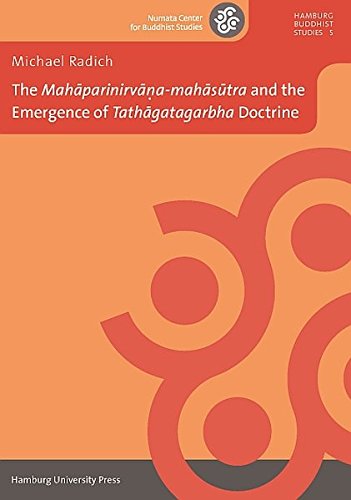- Foreword - Michael Zimmermann9
- Acknowledgements11
- Introduction13
- Outline13
- Contributions of this study16
- Part I: Is the Mahāparinirvāṇa-mahāsūtra "Our Earliest" Tathāgatagarbha Text?
- Introduction19
- The portion of MPNMS under consideration ("MPNMS-tg")20
- 1 MPNMS-tg as a "Tathāgatagarbha Text"23
- 1.1 MPNMS-tg as a veritable "tathāgatagarbha text"23
- 1.2 The Tathāgatagarbha-sūtra as a "tathāgatagarbha text"32
- 2 The Date of MPNMS-tg, Relative to Other Tathāgatagarbha Texts35
- 2.1 Does MPNMS-tg refer to (our present) TGS by title?35
- 2.1.1 References to a/the (this?) Tathāgatagarbha-sūtra within
MPNMS-tg37
- 2.1.2 Reference to other titles and texts in MPNMS40
- 2.1.3 MPNMS references to other Mahāyāna texts by title50
- 2.1.4 Relations to other texts without mention of their title53
- 2.2 Similarity of one simile between MPNMS-tg and TGS56
- 2.3 Summary57
- 3 Evidence for the Absolute Dates of MPNMS-tg and Other Tathāgatagarbha Scriptures59
- 3.1 Evidence for the absolute date of MPNMS-tg59
- 3.2 Independent evidence for the absolute dates of TGS83
- 3.3 Summary85
- 3.4 Takasaki’s chronology: The Anūnatvāpūrṇatva-nirdeśa and Śrīmālādevīsiṃhanāda-sūtra85
- 3.5 Chronological relations between MPNMS-tg and other texts in the MPNMS group97
- 3.6 Conclusions99
- Part II: The Mahāparinirvāṇa-mahāsūtra and the Origins of Tathāgatagarbha
Doctrine
- Introduction101
- Schmithausen’s criteria for a "scenario of origin" for Buddhist concepts102
- 4 Tathāgatagarbha, the Problem of Maternity, and Positive Corollaries to
Docetic Buddhology105
- 4.1 Terms105
- 4.2 Docetism as a corporeal issue107
- 4.3 The extension of docetism beyond death and birth110
- 4.4 Negatively-framed docetism about the Buddha’s conception,
gestation and birth115
- 4.5 "Material-miraculous" positive corollaries of docetism about the
Buddha’s conception, gestation and birth118
- 4.6 The material-miraculous, "docetic" womb124
- 4.7 Dharmakāya and vajrakāya as positive corollaries of corporeal
docetism129
- 4.8 Tathāgatagarbha as a "soteriological-transcendent" positive corollary
to docetism about the Buddha’s conception, gestation and birth132
- 4.9 Docetism and the problem of the Buddha’s mother(s)143
- 4.10 Docetic reinterpretations of other branches of kinship154
- 4.11 Summary155
- 5 Garbha and Dhātu159
- 6 Conclusions169
- 6.1 Summary169
- 6.2 Directions for future research171
- Appendix 1 Terms related to "tathāgatagarbha" in MPNMS175
- Appendix 2 Chinese zang 藏 (esp. in DhKṣ) and "secret teachings"193
- Appendix 3 Further apparent historical detail in the MPNMS group prophecy complex199
- 1 *Sarvalokapriyadarśana199
- 2 A "*cakravartinī"202
- 3 Trials and tribulations of the espousers of the MPNMS group205
- Appendix 4 "MPNMS-dhk" and "MPNMS-tg"207
- Appendix 5 "Kataphatic gnostic docetism"211
- Abbreviations215
- Bibliography219
- Index247
Michael Radich argues that the Mahāparinirvāṇasūtra was the first appearance of the term tathāgatagarbha. Previous scholars have assumed that the term first appeared in the Tathāgatagarbhasūtra, although as Radich's thesis advisor Michael Zimmermann has argued, the term was possibly added to the scripture that uses it in its title only in later versions. Radich's argument in this way buttresses Zimmerman's, which has been disputed by other scholars. His thesis rests partly on the Mahāparinirvāṇasūtra's unique exposition of the term, one that was not repeated elsewhere.
In this scripture, tathāgatagarbha is not an exhortation to practice, or a means to soothe fears of nihilism. Instead, it is an explanation of how a perfectly pure being such as a buddha could arise out of a polluted and degraded human being. It would seem that early Mahāyāna Buddhists had a misogynistic crisis similar to that of early Christians: an inability to accept that their divine hero could have been born from a woman. Radich places this intellectual struggle within a context of "docetic Buddhism," meaning the attempt to explain that what one sees—the Buddha in a body—is not what is ultimately real; appearances are always deceiving. Similar to the way Yogācāra built on emptiness-theory with positive descriptions of the ultimate, the
Mahāparinirvāṇasūtra, Radich argues, offered a positive solution to the origin of buddhahood: because buddhas could not be generated out of a human womb, they were given metaphorical wombs—garbha —that are present in all sentient beings. Radich presents his argument alongside meticulous and extensive textual analysis to support his dating of the
Mahāparinirvāṇasūtra to earlier than the
Tathāgatagarbhasūtra.

